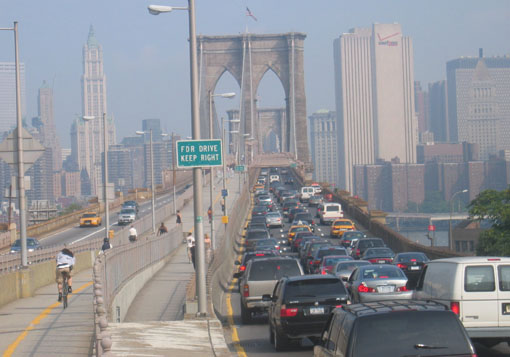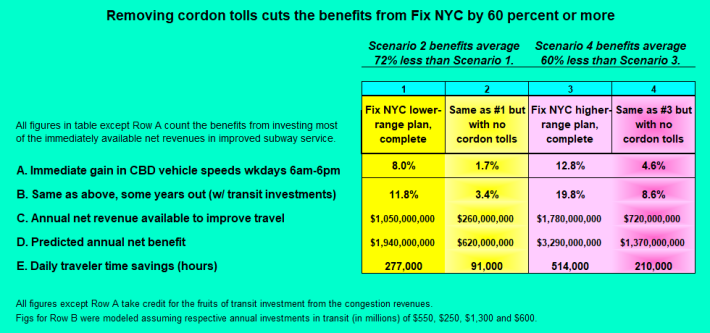Last week, the Cuomo administration took steps to impose a congestion fee on taxi and Uber trips, but not on cars and trucks driven into the Manhattan core. It's a troubling sign that Governor Cuomo may only move forward with a portion of the recommendations from his Fix NYC panel. And that would be a huge mistake.
If Cuomo gives up on a full cordon toll and limits his approach to a surcharge on for-hire vehicles, New York will miss out on most of the benefits it stands to reap from congestion pricing.
The numbers are stark. Without a cordon toll, the time savings from reduced traffic congestion drops by at least 60 percent. The revenues available to improve transit drop by 60 percent or more as well, leading to a corresponding drop in straphanger time savings from more reliable trains.
You can generate these forecasts by running any Fix NYC scenario on my BTA spreadsheet, then zeroing out the tolls, leaving just surcharges on yellow cabs and Ubers within the Manhattan taxi zone. The result: Every benefit promised for congestion pricing -- less gridlock, better transit, cleaner air, a happier and more productive workforce -- shrinks by 60 to 75 percent.
This shouldn’t surprise anyone. Although robust surcharges on taxis, Ubers, Lyfts, and the like are vital to congestion pricing, the cordon toll is even more essential.
Pricing only for-hire trips would have perverse rebound effects, leading to even more personal car travel in the congested heart of the city. That's because drivers who now leave their cars at home will exploit much of the space cleared out due to higher cab and Uber fares. Without a cordon toll to reduce 15-20 percent of car trips into the Manhattan CBD, we can kiss most of the time savings goodbye, not to mention the political support of players in the for-hire vehicle industry who will be left holding the bag.
Consider the Fix NYC scenario with a $11.52 fee to enter the Central Business District in effect for enough time to capture 71 percent of car trips that cross into the congestion zone, which also tacks $3-$5 onto the cost of for-hire trips that touch Manhattan up to 96th Street. I call this the "Higher-Range Plan," and it promises 514,000 hours of travel time savings for drivers and transit riders each weekday, with $3.3 billion in total annual net benefits.
But take away the cordon toll, and these gains drop to 210,000 saved hours and less than $1.4 billion in net benefits. Other Fix NYC plan versions show even more severe decreases. Without the cordon toll, the benefits from a “Lower-Range Plan” shrink by more than 70 percent:
These findings ought to dispel the enthusiasm for Uber-only charges from commentators like Felix Salmon, the finance blogger who profiled me and the BTA for Wired magazine in 2010. Writing again in Wired this week, Salmon states baldly that congestion pricing "won’t do much to fix gridlock in our cities -- [whereas] a traffic tax on Uber and Lyft could get cars moving again.” Really? An uptick of 1.7 to 4.6 percent is “moving”?
Had Salmon reached out to me, I would have gladly shared my figures indicating that the improvement in CBD travel times from for-hire surcharges alone will be several times less than that from pairing the surcharges with a cordon toll. Moreover, the drop in speed gains outside the CBD is even more precipitous: From a 7 percent improvement on the streets approaching the Central Business District, to under 2 percent.
The reason isn’t hard to see. Uber and the other app-based ride services such as Lyft make up only 25 percent of vehicle mileage in the CBD, and even less during the daytime hours when traffic congestion peaks. For yellow cabs, the share of mileage is likewise 22 percent. Ubers and yellows both have flatter hourly "profiles" than private cars and trucks -- meaning the peaks aren't as high, and they don't contribute as much to intensifying traffic during rush hours. Charging for-hire vehicles alone is like fighting with one hand tied behind your back.
To use a different metaphor, one that the governor’s late father, a one-time Pittsburgh Pirates prospect, might have appreciated: Our transportation crisis has the city down by three runs in the ninth inning. We’ve loaded the bases, thanks to fierce organizing by transit advocates and the table-setting policy recommendations in the Fix NYC report. Charging only for-hire vehicles is no better than a sac fly or groundout that brings in just one run.
What we need, of course, is a congestion pricing grand slam. Our leaders in Albany and City Hall need to deliver.







